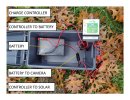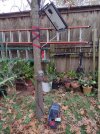Yes, the wattage increased when the sun moved into clear view of the panel, when the sun was perpendicular to the panel and then again was lower in the morning and lower in the afternoon. Most of the measurements were in partial shade as I am attempting to simulate a wooded environment (actual field deployment conditions). The current set up (rigid metal framing) and my schedule does not allow me to easily change the tilt throughout the year, but I might be able to get an adjustment in early summer and late summer. These adjustments would also require adding some type of hinge points to the current frame (not impossible but does change things some). But adjustments and moving and changing batteries is what I am trying to minimize - ultimately, I am trying to build something that will last for 6 winter months.
But funny you mention that "curved panel" option (in lieu of the flat 20watt panel that I am currently testing. I am considering a flexible panel that might be able to do just that. In a perfect world, I could face a curved panel that could face SE (morning sun), S (noon day sun), and all the way around to SW (afternoon sun)... maybe just by wrapping it around a tree trunk - the difficulty would be determining what size panel to use. Right now, I think the 20 watt flat panel is a pretty good candidate that might be able to get a little smaller. Should I go with a curved panel, probably only 25% of the panel would be in an optimal position to collect sun light, so maybe I would need another 20 watt panel. I have my eyes on a very cost effective semi flexible 8 watt panel that has holes (grommets) in each corner that I could tie onto a tree trunk or attach to available smaller limbs with rope, cable or other zip tie - what is fun about the flexible set up and the cable connections, I should be able to eliminate any type of structural frame (that was previously required to support a glass faced rigid type panel).
What is interesting... I think the Cuddeback cameras need about 1 to 2 Wh per day (based on my last set of 4D batteries lasting 60 days). Assuming that a nominally 20 watt panel could generate up to 20Wh per hour, you only really 10 or 15 minutes of full sun to get 2 Wh each day. If that same panel were to be placed with the worst sun exposure possible, I would think surely you could get 2 watts of output for an hour or two each day... this is why I am thinking that I might be able to make a flexible 8 watt panel work with just a little sun each day. This is the next experiment (if my wife lets me continue to buying solar panels and batteries to see what works best).


